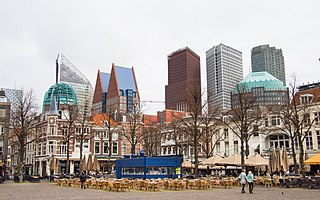
The Hague is the capital city of the South Holland province of the Netherlands. With a population of over half a million, it is the third-largest city in the Netherlands. Situated on the west coast facing the North Sea, The Hague is the country's administrative centre and its seat of government, and while the official capital of the Netherlands is Amsterdam, The Hague has been described as the country's de facto capital since the time of the Dutch Republic.

Scheveningen is one of the eight districts of The Hague, Netherlands, as well as a subdistrict (wijk) of that city. Scheveningen is a modern seaside resort with a long, sandy beach, an esplanade, a pier, and a lighthouse. The beach is popular for water sports such as windsurfing and kiteboarding. The harbour is used for both fishing and tourism.
The Royal Netherlands Navy is the maritime service branch of the Netherlands Armed Forces. It was founded on 8 January 1488, making it the third-oldest naval force in the world.
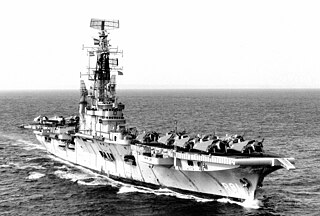
HNLMS Karel Doorman (R81) was a Colossus-class aircraft carrier of the Royal Netherlands Navy. Formerly the British ship HMS Venerable, she was sold to the Netherlands in 1948 as a light attack carrier. In 1960, she was involved in the decolonization conflict in Western New Guinea with Indonesia. In the mid 1960s, her role was changed to anti-submarine warfare carrier and only ASW aircraft and helicopters were carried. An engine room fire took her out of service in 1968. She was sold to Argentina in 1969 and renamed ARA Veinticinco de Mayo.

The Hague School is a group of artists who lived and worked in The Hague between 1860 and 1890. Their work was heavily influenced by the realist painters of the French Barbizon school. The painters of the Hague school generally made use of relatively somber colors, which is why the Hague School is sometimes called the Gray School.

De Rijp is a village and former island in the Dutch province of North Holland. It is a part of the municipality of Alkmaar, and lies about 10 km northwest of Purmerend, between the Schermer and the Beemster polders. Before the poldering of the lakes surrounding it, De Rijp was famous for its herring industry. Today it is known for its characteristic rijksmonuments, which include some of the oldest wooden houses of North Holland.
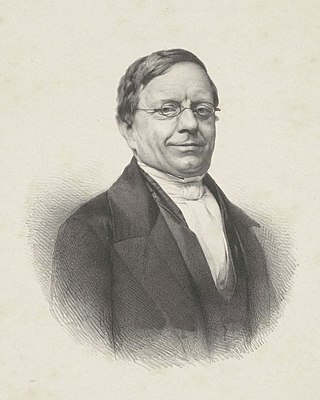
Abraham Jacob van der Aa was a Dutch writer best known for his dictionaries, one of notable people and the other of notable places in the Netherlands.
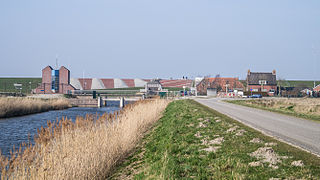
Noordpolderzijl is a hamlet in the Dutch province of Groningen. It is located in the municipality of Het Hogeland, about 4 km northwest of Usquert.

Anholt is a hamlet in northeast Netherlands. It is located in the municipality De Wolden, Drenthe, about 2 km west of Pesse.

The Flag of New Holland, also known as the flag of Dutch Brazil, was the flag used by the Dutch West India Company for the territories that were under its control in Brazil from 1630 until 1654. In this period, Brazil was not granted its own flag, and only the flags of its colonizers or rulers were used.
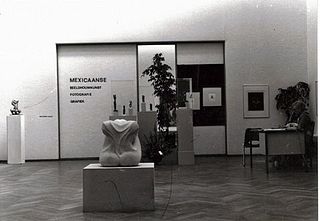
Pulchri Studio is a Dutch art society, art institution and art studio based in The Hague ('s-Gravenhage), Netherlands.
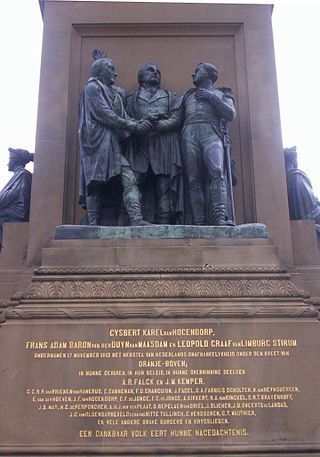
The Triumvirate of 1813, or the Provisional Government, governed the Netherlands briefly at the end of the Napoleonic era, before William I of the Netherlands came to the throne. It consisted of Gijsbert Karel van Hogendorp, Frans Adam van der Duyn van Maasdam and Leopold van Limburg Stirum.

The Statenvlag is the name of the flag of the States-General of the Dutch Republic, the red-white-blue tricolour flag replacing the older orange-white-blue Prince's Flag in the mid 17th century. The modern national flag of the Netherlands, the exact colours of which were confirmed in 1937, is based on this historical flag. It also resembles the modern Flag of Luxembourg.
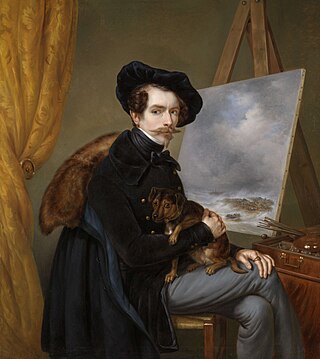
Johan Hendrik Louis Meijer was a Dutch painter, etcher, lithographer, and draftsman. He painted in the Romantic tradition and is best known for his seascapes.

Lucas Smout the Younger or Lucas Smaut was a Flemish painter of coastal and country scenes who was active in Antwerp.

The coat of arms of Enkhuizen has been the coat of arms ever since Enkhuizen received borough rights in 1355. The coat of arms was acknowledged in 1816 by the High Council of Nobility, the coat of arms has not been changed ever since.

The name Persijn or Persyn originates from what is said to be one of the oldest and noblest families from Kennemerland. In the 13th century, a branch of the Persijn family concerns the lords of Waterland and Amsterdam. They resided in the lost castle of Huis te Velsen north of Haarlem. Its oldest known ancestor was Dirk Persyn, who was given the title of courtier of the Count of Holland in 1162.

HNLMS Onverschrokken (A856), also known as HNLMS Mercuur (A856), was an Onversaagd-class minesweeper of the Royal Netherlands Navy (RNN). Soon after being taken into service of the RNN, the ship was put into reserve alongside the rest of the minesweepers of the Onversaagd class. Later, in 1973 she was renamed as HNLMS Mercuur (A856) and used as submarine support ship till her decommissioning in 1987. Nowadays, she is a museum ship that can be visited in Vlissingen.
This page shows the coats of arms, heraldic achievements, and heraldic flags of the House of Nassau.

The Vuurbaak van Katwijk aan Zee is a Dutch lighthouse in Katwijk aan Zee, in South Holland, on the North Sea. It is the second oldest lighthouse in the country; only the Brandaris (1594) is older. The lighthouse was essentially just a 12-metre-tall (39 ft) tower on top of which a fire was lit whenever Katwijker fishers were out at sea. The fire was replaced with an oil lamp in the mid-19th century; by the early 1900s there were no fishing vessels from Katwijk and the lighthouse became inactive.























